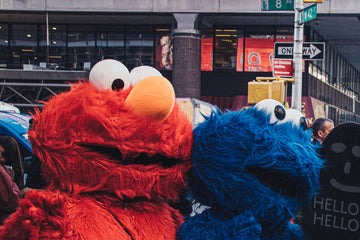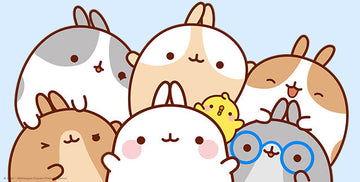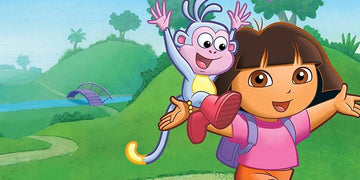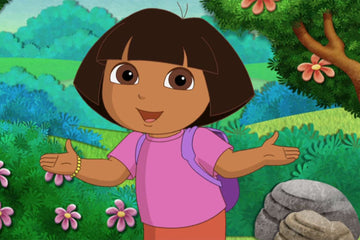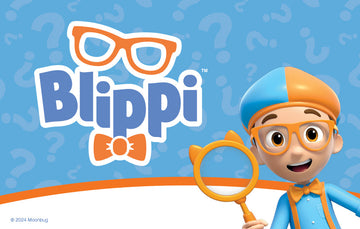Who doesn't love the colorful world of Sesame Street? From Big Bird's sunny days to Count von Count's numerical obsessions, we've all been touched by this charming neighborhood. But have you ever wondered how it all began?
In this article, I'll delve into the captivating story of Sesame Street. We'll explore its humble beginnings, the visionaries behind its creation, and how it's evolved over the decades to remain a beloved fixture in children's television. So, join me as we journey down memory lane, back to where we first met our favorite puppet pals. Let's discover the magic behind those iconic street signs.
The Creation of Sesame Street
Let's journey further down memory lane to explore how Sesame Street came to be.

The Idea Behind the Show
Sesame Street's concept wasn't a stroke of sudden inspiration, but the product of thoughtful planning and dedicated collaboration. Joan Ganz Cooney, a television producer, and Lloyd Morrisett, a psychologist and philanthropist, shared a common belief: that television could be both entertaining and educational for children. They saw an opportunity to harness the power of media to reshape early childhood experiences, an idea that stemmed from an educational dinner party in 1966.
Key People Involved
Joan Ganz Cooney, the dynamic force behind the show, transformed her revolutionary idea into reality. As one of the creators of Sesame Street, she established the Children's Television Workshop (CTW) in 1968, leveraging her TV production experience. Lloyd Morrisett, another pivotal figure, brought his expertise in psychology to ensure the show's content was tailored to foster cognitive development in children. Jim Henson, the famed puppeteer, breathed life into the imaginary world of Sesame Street with his Muppets, creating unforgettable characters like Big Bird, Elmo, and Bert and Ernie.
Even though the behind-the-scenes team was instrumental in launching the show, the real stars were the inhabitants of Sesame Street. Every puppet, human character, and real-life guest contributed to creating a vibrant, diverse, and inclusive world—one where learning and growing are an ongoing journey of fun and adventure.
The Educational Objective of Sesame Street
Joan Ganz Cooney and Lloyd Morrisett didn't simply want to entertain young audiences, they aspired to transform television into a powerful tool for education. Let's delve into the educational foundation that directs Sesame Street.
The Curriculum-Based Model
At Sesame Street’s core, it's a curriculum-based model that underpins its enthusiasm.However, don't mistake this model for a dull classroom curriculum. It masterfully integrates learning objectives into engaging content, making education enjoyable for kids. For instance, the show's episode format champions a theme, such as numeracy or literacy, and carries it through various segments, tying in live-action sketches, animations, Muppets-led lessons and even heartfelt songs—a testament to the innovation of curricula used on this show.
Social-Emotional Learning in Sesame Street
Sesame Street also emphasizes social-emotional learning, fostering qualities like resilience, kindness, and empathy in its young audience. For example, several episodes focus on Big Bird’s experiences of lost or warm friendship, imparting valuable lessons about relationships, emotions and self-belief.
And now, looking for adorable, high-quality clothes for your little ones? Check out Sandilake clothing, an award-winning clothes store featured on Shark Tank. Their best-sellers have a wide array of trendy styles for girls and cool, minimalistic designs. Make any day special with Sandilake clothing. Explore their collections here.
The Shows Iconic Characters
Continuing from the educational influence of Sesame Street, let's turn our focus towards its iconic characters. Their development and impact on viewers have significantly contributed to the show's success.
Development of Characters
From the friendly giant Big Bird to the lovably grumpy Oscar the Grouch, each character on Sesame Street carries a unique personality. The show's creators utilized puppetry to bring these characters to life, tapping into the inventive genius of master puppeteer Jim Henson. His innovative puppet creations, termed "Muppets", play substantial roles in the show. Each Muppet character, such as the enthusiastic Elmo or the ever-hungry Cookie Monster, embodies different facets of the human personality. Their diverse traits help children identify with the characters, making the learning process more relatable and engaging.
Impact of Characters on Viewers
On an impact perspective, the show's characters exert a deep influence on their young viewers. The amiable disposition of characters like Elmo and Big Bird promotes kindness and empathy. Characters with different abilities, like Julia who has autism, foster a sense of inclusivity and acceptance. For instance, when viewers see how the other characters interact with Julia, they understand that everyone should be treated with equal love and respect.
Furthermore, characters like Count von Count make learning fun. As the Count engages in his favorite pastime, counting, children learn about numbers in an engaging way. This subtly drives home the lesson of numeracy, reinforcing the show's educational goals.
Moreover, through the experiences of the characters, children navigate various social and emotional situations. These scenarios impart valuable lessons and coping strategies that help the young viewers understand and manage their own feelings and relationships.
While we've already discussed how beneficial Sesame Street can be for educational purposes, it is important to understand that these beloved characters aren't just fun to watch–they're an essential part of the show's comprehensive approach to early childhood education.
Remember, a good article stands out with the support of great clothing. Stand out with dashing clothes from none other than the award-winning Sandilake Clothing. As seen on Shark Tank, Sandilake offers stunning outfits for babies and kids. Make your choices today from our best sellers or our distinctive girls' collections. Visit Sandilake Clothing now to explore more.
Highlights throughout Sesame Street’s History
Embarking on the journey, let's trace the noteworthy highlights and story-laden pathway of Sesame Street's splendid history. This synopsis chronicles their laudable endeavors in celebrating diversity, tackling omnifarious social issues, and, moreover, various milestones that etched memorable moments.
Celebrating Diversity and Tackling Social Issues
Countless episodes of Sesame Street emphasize diversity and societal challenges, crafting wonderfully educational scenarios for young viewers. They have a character roster, teeming with variegated personalities, attitudes, backgrounds, and attributes. A prime illustration lies in Julia, a character exhibiting autism spectrum characteristics, who helps demystify this often misunderstood neurological condition. Every character, every storyline blends subtly into a framework of edutainment, making these complex themes manageable for the young minds, thereby promoting empathy, acceptance, and understanding in their hearts.
Milestones and Memorable Moments
Sesame Street, over its five decades of existence, has earned copious noteworthy moments and milestones. The first episode, aired in 1969, showed Big Bird and a heartfelt welcome from Gordon, symbolizing the start of an era. With its 50th anniversary in 2019, Sesame Street's journey so far is star-studded with recognition and laurels, including 193 Emmy Awards and 11 Grammy Awards.
However, it's not merely the awards: It's those poignant moments that hit home, whether it's Big Bird learning about loss or Elmo explaining racial discrimination vividly. Even minor instances, like the advent of Abby Cadabby, the first female Muppet lead or the ongoing celebration of multi-linguistic programming diversification, dictated the show’s continuous commitment to delivering embedded educational content in a warm, approachable manner.
I must also mention this exclusive online clothing store, Sandilake Clothing, which offers delightful apparel for both babies and kids. They have an exquisite collection that ranges from über-cool tees to whimsical dresses. The best-sellers and girls' section deserve your attention. After all, who wouldn’t want to dress their little ones in the quality threads the Shark Tank vetted brand has on offer?
Criticism and Controversies surrounding Sesame Street
Even beloved institutions like Sesame Street aren't immune to criticism and controversy. For instance, in the late '70s, researchers published arguments suggesting that the show's quick-paced, magazine-like format might contribute to short attention spans in children. Parents, they posited, might be placing too much emphasis on the educational value of the show, possibly relying on it as an alternative to more direct forms of early education.
However, Sesame Street's production team, firmly believing in the efficacy of their format, challenged these assertions by citing their own research. This laid out that the show's structure helped engage young minds effectively, contributing to their cognitive development rather than hindering it.
There's also the ongoing conversation around character Grover's controversial language use in a late 2018 episode. Some viewers purported that he used inappropriate language, while others adamantly disagreed. The segment, naturally, went viral, creating a divide in Sesame Street's usually harmonious audience.
Elmo, despite his popularity, has also been a bone of contention. Critics have noted his simplistic speech patterns as potentially detrimental to children's language acquisition. The show's team, on the other hand, expressed that Elmo's toddler-like language was a part of his relatable charm, aiding more in keeping children's attention, a crucial factor for imparting educational content.
Lastly, I can't avoid retelling the tale of Kevin Clash, the voice behind Elmo. Allegations around inappropriate conduct emerged in the early 2010s leading to a formal investigation and Kevin's resignation from Sesame Street. This ordeal proved to be a terriblly upsetting chapter in Sesame Street's otherwise inspiring narrative.
Of course, these events pale beside a host of commendations and the show's remarkably positive contributions spanning more than half a century. Nevertheless, it's crucial to acknowledge these aspects when discussing the full, rich history of Sesame Street.
Before closing this segment, let me shine the spotlight back onto Sandilake Clothing. They are proud partners with Sesame Street, offering a special line of Sesame Street-themed apparel for children. Their collections are just as diverse, creative, and engaging as the show itself. So, do explore their various offerings at Sandilake Clothing main page, or check out their best sellers and girls' collection.
The Future of Sesame Street
The future of Sesame Street appears vibrant, incorporating innovative technology and engaging learning schemes in its arsenal.
Technological Innovations and New Learning Modules
A new era of Sesame Street brings cutting-edge technologies to play. Integration of augmented reality (AR) tools magnifies interactive learning, where kids engage with objects and characters in a virtual environment. For instance, the Big Bird's Words app lets children find and identify words in their surroundings using smartphone cameras, merging digital and real worlds.
Not confined to TV screens, Sesame Street expands to platforms like YouTube, gaining 5 million subscribers. It's also implanted in teaching tools, delivering lessons through podcasts, e-books, and apps. One notable app is Elmo Loves 123s, teaching arithmetic and numbers to kids with fun activities and games.
Further advancements come with modules specialized for tackling critical topics. The 'See Amazing in All Children' module, for example, assists families in understanding autism, providing strategies and support through digital storybooks and videos. It's a profound step towards inclusive education, playing off the precedent set by Julia in previous episodes.
Partnerships also form a pivotal part for future-proofing Sesame Street. Sandilake Clothing, our partner, offers Sesame Street-themed apparel, adding a dash of the program’s essence to children’s wardrobes. Their engaging collection is just a click away at Sandilake Clothing, with additional selections featured in their best sellers and girls' section.
Sesame Street's longevity is testament to its adaptability. It continues shaping itself for ever-evolving audiences, reinforcing its pioneering status in children's programming. With advanced tools, adaptable learning modules and enthusiastic partners, the future seems nowhere but up for 'the street'. The show that began on a simple ideology of imparting education to every child has become a lexicon of children's learning, seemingly prepared to rock the future.
Impact of Sesame Street on Children Television
Allow me to start by saying Sesame Street's influence stretches far beyond its colorful sets and friendly characters. Its decades-long presence in children television, coupled with its persistent dedication to quality education, has reshaped how learning is approached in children's programming. This pioneering show broke the mold, proving that education and entertainment could exist harmoniously, inspiring future productions to follow suit.
Unmatched Viewership
Sesame Street, as a pioneer in the children television space, boasts of an unmatched reach. With broadcasts in over 150 countries, it's no exaggeration to say that Sesame Street has impacted millions of children worldwide. Its characters and messages have become engrained in our collective cultural fabric.
Curriculum-Based Learning Approach
Sesame Street's most significant contribution to children television is arguably its adherence to a robust curriculum-based learning approach. The program consistently distills complex topics into digestible information by using creative and engaging segments, ensuring children grasp, remember, and enjoy the material. For example, characters like The Count often break numbers and arithmetic down into playful, memorable lessons.
Role-Model Characters
Characters from Sesame Street are not simply puppets. They've become role models for millions of children, providing a safe and relatable lens through which kids can learn about the world. Big Bird, Elmo, Cookie Monster, and Oscar – they all represent certain human characteristics and traits, assist children in processing emotions, understanding diversity, and even navigating complex social interactions.
Promotion of Diversity and Inclusion
Sesame Street has also made remarkable strides in promoting diversity and inclusion in children television. It regularly introduces characters with various backgrounds and abilities, creating an environment where all children can see themselves represented, fostering an early understanding of real-world diversity.
Conclusion
Sesame Street's story is one of resilience, innovation, and a steadfast commitment to educating children. Its iconic characters like Julia, Big Bird, and Elmo have not only entertained but also taught critical life lessons, promoting diversity and inclusion. Despite facing criticisms and controversies, it's the show's ability to adapt and evolve that's kept it relevant for over five decades. Its future looks promising, with plans to leverage technology like augmented reality for interactive learning and expanding its reach through platforms like YouTube. With its influence spanning over 150 countries, Sesame Street continues to set the bar high for children's television. Its partnership with Sandilake Clothing further extends its impact, bringing Sesame Street's magic into the lives of children through themed apparel. The show's story is a testament to its enduring legacy and its unwavering mission to make learning fun, accessible, and meaningful for all children.

